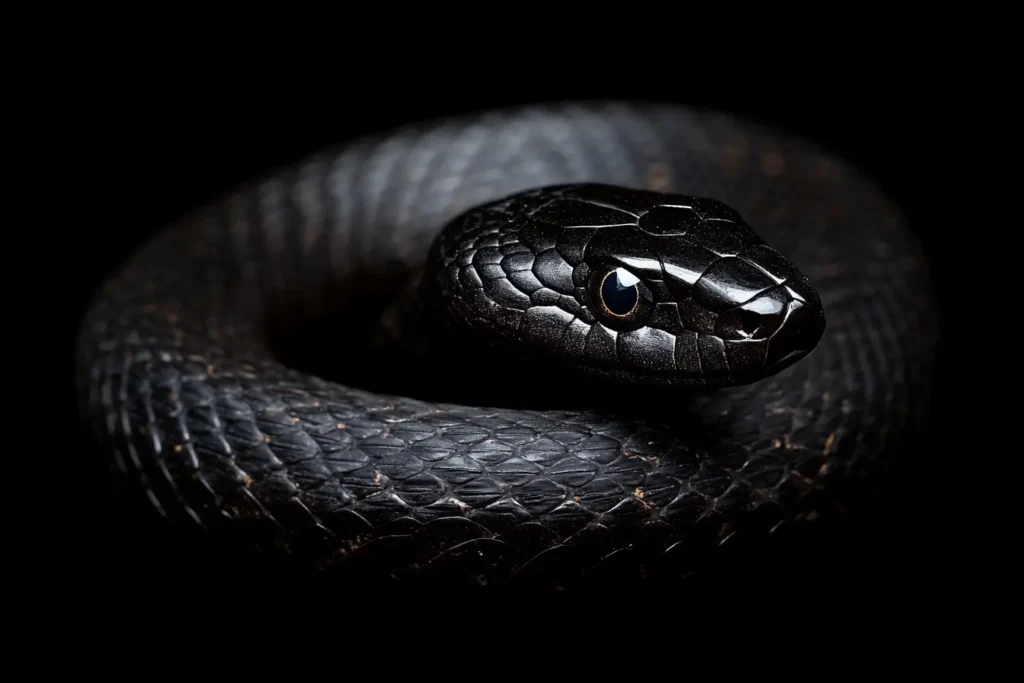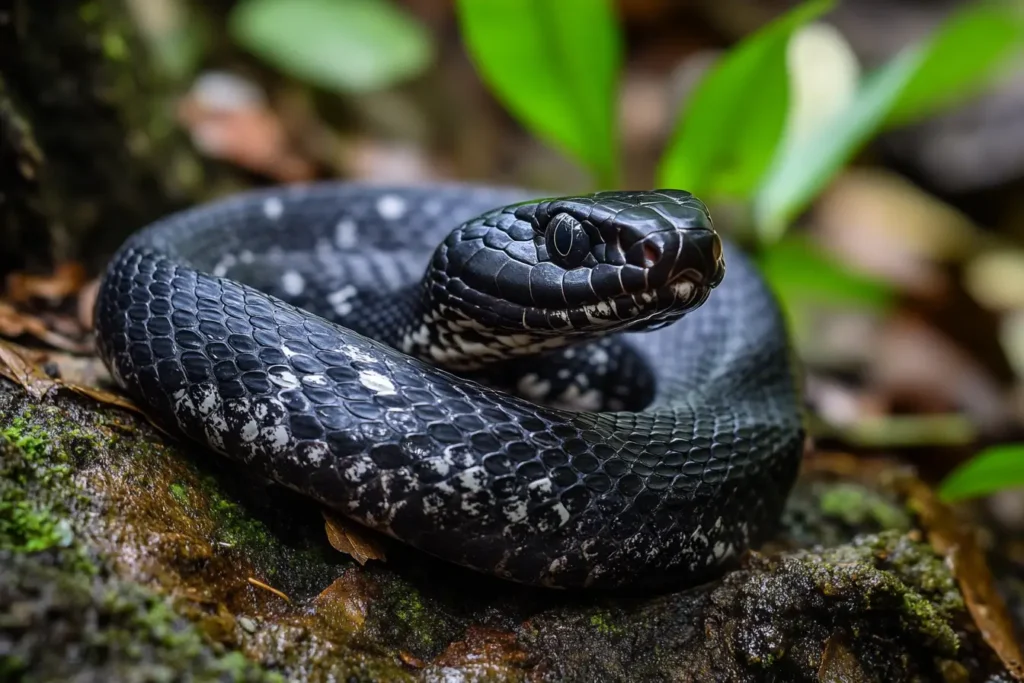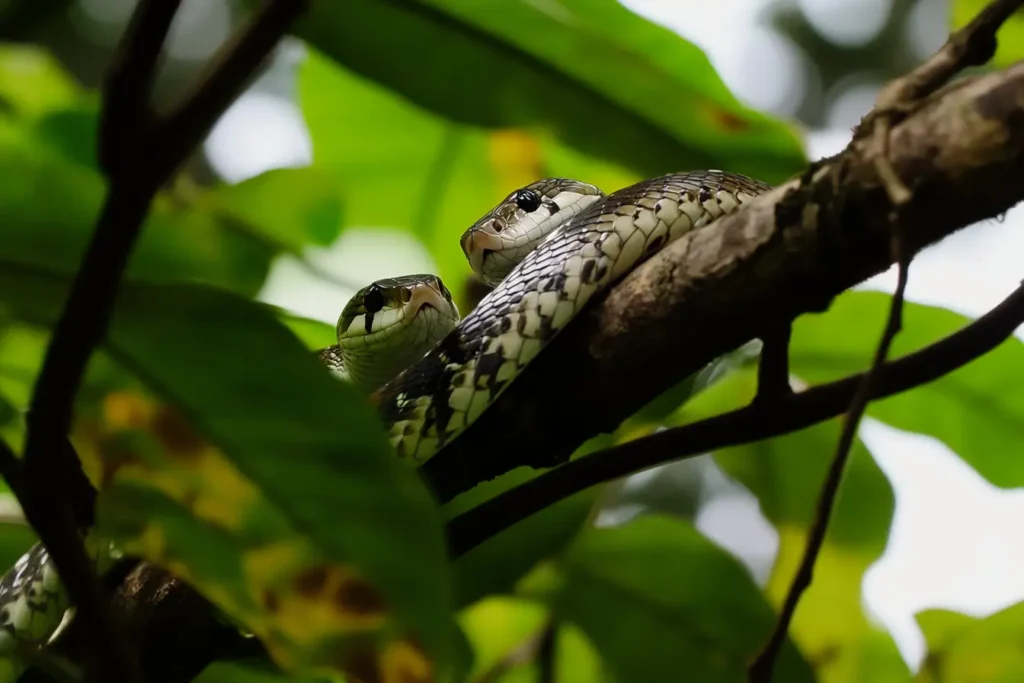Black snakes with a ring around their necks are common in the U.S. They belong to species with unique traits.
This article will explore these snakes, including how to spot them, where they live, and what makes them special.
These snakes range from small ring-necked snakes to big black rat snakes.
They are found all over North America.
Knowing how to tell them apart is key to understanding and living with these snakes.
Introduction to Black Snakes with Neck Rings
Black snakes in North America have a special trait. Some have a ring or band around their necks.
These black snakes with neck rings are not just pretty; they also help their ecosystems.
Overview of Common Species
The ring-necked snake (Diadophis punctatus) and the black rat snake (Pantherophis obsoletus) are well-known.

They live in the eastern and central U.S., and some even migrate to Canada and Mexico.
Identifying Characteristics
These beautiful black snakes with neck bands have a special neck ring. But each species is different. You can tell them apart by size, colour, and how they act.
| Species | Average Length | Neck Ring Color | Body Color | Habitat |
|---|---|---|---|---|
| Ring-necked Snake | 10-15 inches | Yellow, orange, or red | White or light grey | Moist wooded areas |
| Black Rat Snake | 36-72 inches | White or light gray | Solid black | Woodlands, farmlands, and suburban areas |
Ring-necked Snakes: A Closer Look

The ring-necked snake is a small, slender snake.
It is one of the most recognizable black snakes with neck rings.
These snakes are 8-14 inches long and have a smooth, black or grey body.
They have a yellow, orange, or cream-coloured ring around their necks, yellow, orange, or red bellies, and black half-moon markings down the centre.
Physical Description
Ring-necked snakes are known for their dark upper surface and bright underbelly.
Adults can grow over a foot long, and some in Florida can reach up to 14 inches.
These snakes have a sleek, slender build. They also have a smooth, glossy appearance.
Geographic Distribution
Ring-necked snakes are found in the eastern and central United States, parts of Canada, and Mexico.
The southeastern states, especially Florida, have the most.
They live in rocky streams, forested slopes, and even suburban areas.
These snakes are adaptable to different habitats.
Ring-necked snakes are mostly active at night, making them hard to see during the day.
However, their unique look and gentle nature make them interesting to watch.
Black Rat Snakes with Neck Rings
Black rat snakes are known for their neck rings. They can grow up to 6 feet long.

Their bodies are solid black or dark grey, and they have a white, cream, or yellow band around their necks.
These snakes are found in the eastern and central United States, stretching from New England to the Gulf Coast and as far west as Texas.
Black rat snakes are great climbers. They live in forests, rocky areas, and even suburban neighbourhoods.
They help control rodent populations. But, they might bite if they feel threatened or are handled wrong.
| Characteristic | Description |
|---|---|
| Size | Up to 6 feet in length |
| Body Color | Forests, rocky areas, suburban neighbourhoods |
| Neck Ring | White, cream, or yellow band around the neck |
| Habitat | Behaviour |
| Behavior | Excellent climbers, control rodent populations |
Black rat snakes are common in many parts of the United States. They are vital to the local ecosystem.
By knowing about their characteristics and behaviour, we can better appreciate and live with these fascinating snakes.
Southern Black Racer: A Ringed Serpent
The southern black racer (Coluber constrictor priapus) is a type of black racer snake. It often has a neckring.
These fast and agile snakes live in the southeastern United States, in open areas like meadows and wooded edges.
Habitat and Behavior
Southern black racers defend themselves by coiling their tails and showing their bright undersides.
They can grow up to 706 mm (27.8 inches) long. In Virginia, their average length is 400 mm (15.7 inches).
In Virginia, these snakes are active from April 10 to October 20. They like to stay at a body temperature of 17.6 ± 0.4°C.
They eat earthworms, salamanders, and lizards, helping the ecosystem.
These snakes face danger from other snakes and domestic cats.
Knowing about their habitat and behavior helps us live peacefully with them.
Black Snakes with a Ring Around Neck
Many black snakes with neck rings are common.
These include the ring-necked snake, black rat snake, and southern black racer.
Other species, like the Baird’s rat snake, the Great Plains rat snake, and the Everglades rat snake, also have this feature.
They can be found in different parts of the United States.
The banded black snakes or ringed neck serpents look striking.
They have solid black or dark grey bodies. A ring around their neck makes them stand out.
Knowing how to tell these snakes with neck bands apart is important for safety and understanding.
- The original description 1859 of the Diadophis arnyi species from Hyatt, Anderson County.
- A report in 1860 on Diadophis occipitalis from central Kansas.
- Listing of three Lampropeltis calligaster specimens collected in Kansas in 1860.
- Reference to the presence of one Carphophis vermis from Fort Scott in 1882.
- Mention of one Lampropeltis holbrooki from Fort Riley in 1882.
- Four Thamnophis sirtalis specimens were found in Kansas and two in Little Blue River, Kansas 1882.
- The mention of a Prairie Rattlesnake (Crotalus viridis) was first reported from Riley County, Kansas 1927.
- Reference to a Prairie Rattlesnake specimen at Kansas State University in 1927.
Adult ring-necked snakes are 10-14 inches long. Hatchlings are 3-4 inches.
These ringed black snakes live in almost every habitat in Oklahoma.
They are found all over the United States and in Mexico.
Baird’s Rat Snake and Other Banded Species

The Baird’s rat snake is found in Texas and northeastern Mexico. It has a black or dark grey body with a white or cream-coloured band around its neck, making it a unique and striking sight.
The Great Plains and Everglades rat snakes are also banded black snakes.
The Great Plains rat snake lives in the central United States.
The Everglades rat snake is found in southern Florida. Each snake has its own look and preferred habitat.
Distinguishing Features
Identifying these snakes can be done by looking at their physical features.
The Baird’s rat snake has a slender build and rough, textured skin. The Great Plains rat snake is stockier and has smoother scales.
The Everglades rat snake stands out with its bright colours.
It has a neck ring and dark bands or blotches along its body, creating a unique and eye-catching pattern.
Range and Ecology
The places where these snakes live vary greatly.
The Baird’s rat snake lives in the south-central United States and northeastern Mexico.
The Great Plains rat snake lives in the central United States, while the Everglades rat snake lives only in southern Florida.
Each snake has found a way to thrive in its home. The Baird’s rat snake likes wooded and open areas.
The Great Plains rat snake prefers grasslands and prairies.
The Everglades rat snake lives in the wetlands of the Florida Everglades.
Coexisting with Ringed Black Snakes
Black snakes with neck rings might look scary, but most are not venomous.
They don’t usually harm humans or pets. Still, it’s wise to be careful around them.
They might spray a bad smell or show off their bright underside by curling their tail.
Safety and Precautions
To live safely with coexisting with black snakes with neck rings, remember these tips:
- Keep a safe distance, and don’t touch the snake
- Let the snake go on its own
- Be careful where you step, especially where ringed black snakes live
- Teach kids to stay back and not touch snakes
- If you see a snake you don’t know, safety tips for dealing with ringed black snakes by calling a wildlife expert or the authorities
By following these precautions when encountering banded black snakes, you can live safely with them. You’ll also learn to appreciate their place in nature.
Conclusion
Black snakes with a ring around their neck are common in the U.S. There are many types, like the ring-necked snake and black rat snake. Each has its own look, where it lives, and how it acts.
Knowing about these snakes helps us see their value in our ecosystems. They play a big role in keeping nature balanced.
We should know how to tell these snakes apart when we see them. The ring-necked snake has smooth scales and a bright collar. When scared, it has a bad smell.
It’s key to know where these snakes live. Some, like the Eastern ring-necked snake, like rocky areas near water. By understanding their homes, we can live with them better.
Learning about black snakes with neck rings is exciting. It shows us how diverse and important they are. By getting to know them, we can appreciate nature more.
FAQ
What are the most common black snake species with a distinct ring around their neck?
The ring-necked snake and the black rat snake are well-known. They both have a ring around their neck.
How can you identify a ring-necked snake?
Ring-necked snakes are small and slender. They have a black or grey body and a yellow, orange, or cream ring around their neck. Their bellies are bright yellow, orange, or red, with black half-moon markings.
Where are black rat snakes with neck rings typically found?
Black rat snakes with neck rings are found in the eastern and central United States, from New England to the Gulf Coast and as far west as Texas.
What are the key features of the southern black racer snake?
The southern black racer is a fast-moving snake with a neck ring. It is known for its agility and defensive behaviours. It may coil its tail and show its white or yellow belly.
Are there other species of black snakes with neck rings besides the ring-necked and black rat snakes?
Yes, there are more species with neck rings. Baird’s rat snake, the Great Plains rat snake, and the Everglades rat snake are examples. Each is found in different parts of the United States.
How can you safely coexist with black snakes that have neck rings?
These snakes are mostly harmless. They are non-venomous and don’t usually harm humans or pets. Stay safe, keep a distance, don’t handle them, and let them be.

